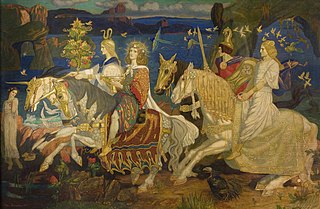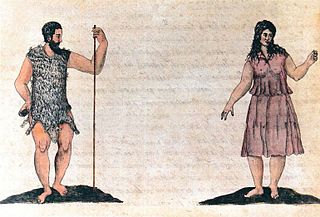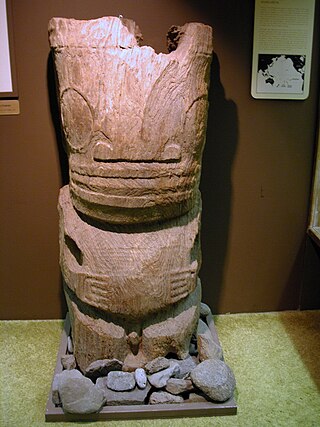Related Research Articles

The TuathaDé Danann, also known by the earlier name Tuath Dé, are a supernatural race in Irish mythology. Many of them are thought to represent deities of pre-Christian Gaelic Ireland.

Aztec mythology is the body or collection of myths of the Aztec civilization of Central Mexico. The Aztecs were Nahuatl-speaking groups living in central Mexico and much of their mythology is similar to that of other Mesoamerican cultures. According to legend, the various groups who became the Aztecs arrived from the North into the Anahuac valley around Lake Texcoco. The location of this valley and lake of destination is clear – it is the heart of modern Mexico City – but little can be known with certainty about the origin of the Aztec. There are different accounts of their origin. In the myth, the ancestors of the Mexica/Aztec came from a place in the north called Aztlan, the last of seven nahuatlacas to make the journey southward, hence their name "Azteca." Other accounts cite their origin in Chicomoztoc, "the place of the seven caves", or at Tamoanchan.

In ancient Greek religion and mythology, Iris is a daughter of the gods Thaumas and Electra, the personification of the rainbow and messenger of the gods, a servant to the Olympians and especially Queen Hera.
Pulotu is the resting place of those passed on in the Polynesian narrative of Tonga and Samoa, the world of darkness "lalo fonua".

In Hawaiian mythology, Laka is the name of two different popular heroes from Polynesian mythology..

The Guanche were the indigenous inhabitants of the Spanish Canary Islands, located in the Atlantic Ocean some 100 kilometres (60 mi) to the west of modern Morocco and the North African coast. The islanders spoke the Guanche language, which is believed to have been related to the Berber languages of mainland North Africa; the language became extinct in the 17th century, soon after the islands were colonized.

Hittite mythology and Hittite religion were the religious beliefs and practices of the Hittites, who created an empire centered in what is now Turkey from c. 1600–1180 BC.
Ki was the earth goddess in Sumerian religion, chief consort of the sky god An. In some legends Ki and An were brother and sister, being the offspring of Anshar and Kishar, earlier personifications of the heavens and earth.

A weather god or goddess, also frequently known as a storm god or goddess, is a deity in mythology associated with weather phenomena such as thunder, snow, lightning, rain, wind, storms, tornadoes, and hurricanes. Should they only be in charge of one feature of a storm, they will be called after that attribute, such as a rain god or a lightning/thunder god. This singular attribute might then be emphasized more than the generic, all-encompassing term "storm god", though with thunder/lightning gods, the two terms seem interchangeable. They feature commonly in polytheistic religions, especially in Proto-Indo-European ones.

Norse, Nordic, or Scandinavian mythology, is the body of myths belonging to the North Germanic peoples, stemming from Old Norse religion and continuing after the Christianization of Scandinavia, and into the Nordic folklore of the modern period. The northernmost extension of Germanic mythology and stemming from Proto-Germanic folklore, Norse mythology consists of tales of various deities, beings, and heroes derived from numerous sources from both before and after the pagan period, including medieval manuscripts, archaeological representations, and folk tradition. The source texts mention numerous gods such as the thunder-god Thor, the raven-flanked god Odin, the goddess Freyja, and numerous other deities.

A liminal deity is a god or goddess in mythology who presides over thresholds, gates, or doorways; "a crosser of boundaries". These gods are believed to oversee a state of transition of some kind; such as, the old to the new, the unconscious to the conscious state, the familiar to the unknown.

Bimbache or Bimbape is the name given to the inhabitants of El Hierro, who inhabited the island before the Spanish conquest of the Canary Islands that took place between 1402 and 1496. The Bimbache are one of several peoples native to the Canaries, with a genetic and cultural link to the Berber people of North Africa. The Bimbache people shared a common link with other aboriginal peoples of the Canary Islands.

Mangarevan narrative comprises the legends, historical tales, and sayings of the ancient Mangarevan people. It is considered a variant of a more general Polynesian narrative, developing its own unique character for several centuries before the 1830s. The religion was officially suppressed in the 19th century, and ultimately abandoned by the natives in favor of Roman Catholicism. The Mangarevan term for god was Etua.

Cook Islands mythology comprises historical myths, legends, and folklore passed down by the ancient Cook Islanders over many generations. Many of the Cook Islands legends were recited through ancient songs and chants. The Cook Islands myths and legends have similarities to general Polynesian mythology, which developed over the centuries into its own unique character.
The Nasamones were a nomadic Berber tribe inhabiting southeast Libya. They were believed to be a Numidian people, along with the Garamantes. They had established their tribe with their important leaders as rulers and they had a sphere of influence from Siwa Oasis to the Gulf of Sitre.
Niuean mythology relates to some of the myths prevalent on the island of Niue, an Oceanic island country in free association with New Zealand. Although Niuean mythology reports a colonization before 500 AD, the island was settled by Polynesians from Samoa around 900 AD. The five principal gods of Niue are known as the tupua, and include Fao, Huanaki, Fakahoko, Laga-iki, and Lagi-atea, who by various accounts, arrived from Fonuagalo, Tulia, Toga-liulu, or perhaps other islands. In Avatele myths, the gods are said to have come from within the earth instead of Fonuagalo. There are also many other gods in Niuean mythology from fish gods to flying rats.
As in the rest of Spain, the majority religion in the Canary Islands is the Catholic Church. The Catholic religion has been the majority since the Conquest of the Canary Islands in the fifteenth century. This religion would largely replace the Canarian aboriginal religion through the prohibition of the latter and syncretism. According to a survey conducted in 2019, Canary Islands is the fifth autonomous community in Spain with the highest percentage of people who declare themselves to be Catholics after the Region of Murcia, Extremadura, Galicia, Aragon, and Castile and León. 76.7% of the population is Catholic.
References
- ↑ Eranoranhan entry The Routledge Dictionary of Gods and Goddesses, Devils and Demons, 2004 y Manfred Lurker, page 58, ISBN 0203643518
- ↑ Moneiba Canary Islands Lore, Gods, Demigods, Heroes, Symbols, and Other Famous Mythological Characters at Mythology Dictionary. Accessed 2013
